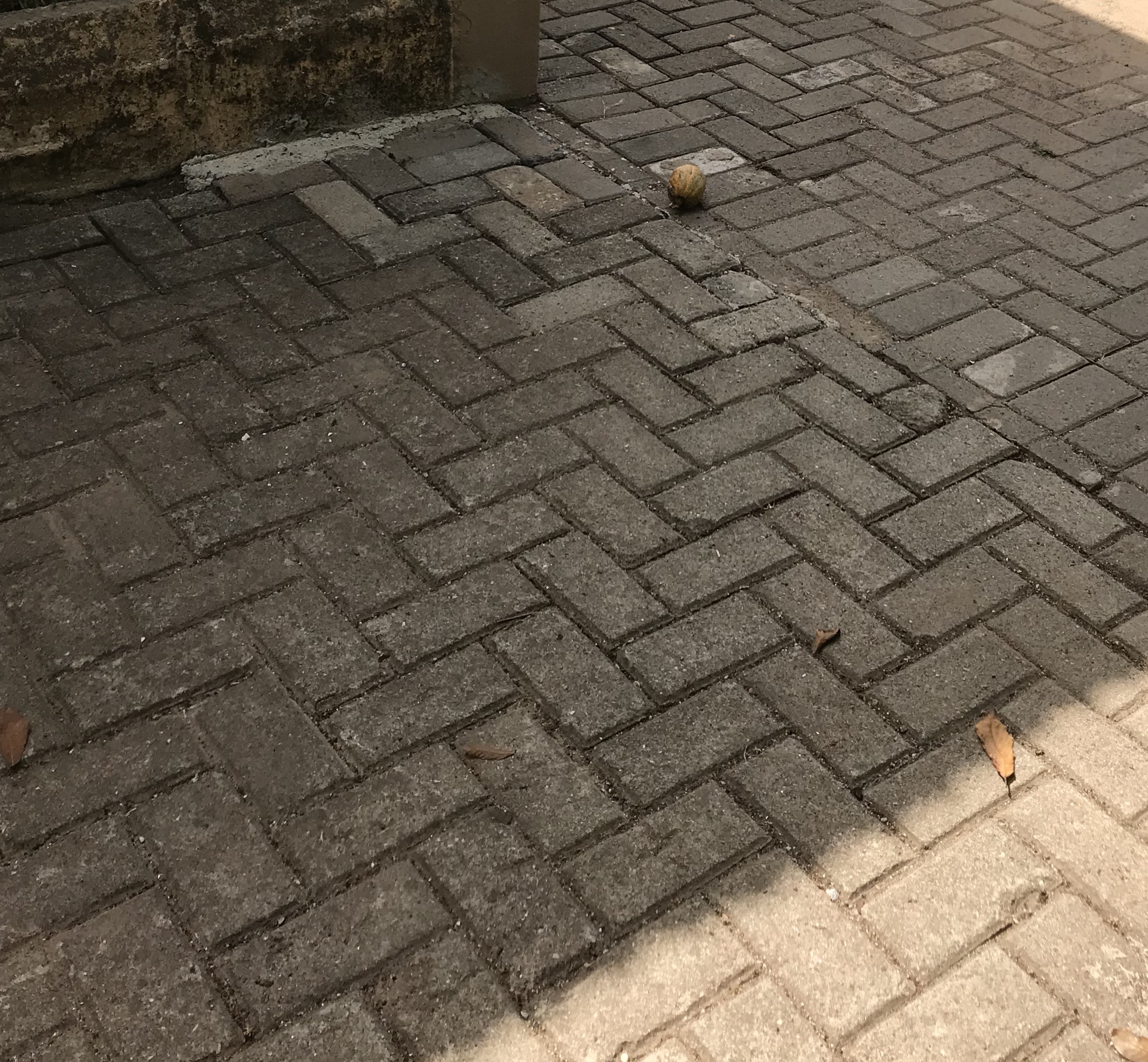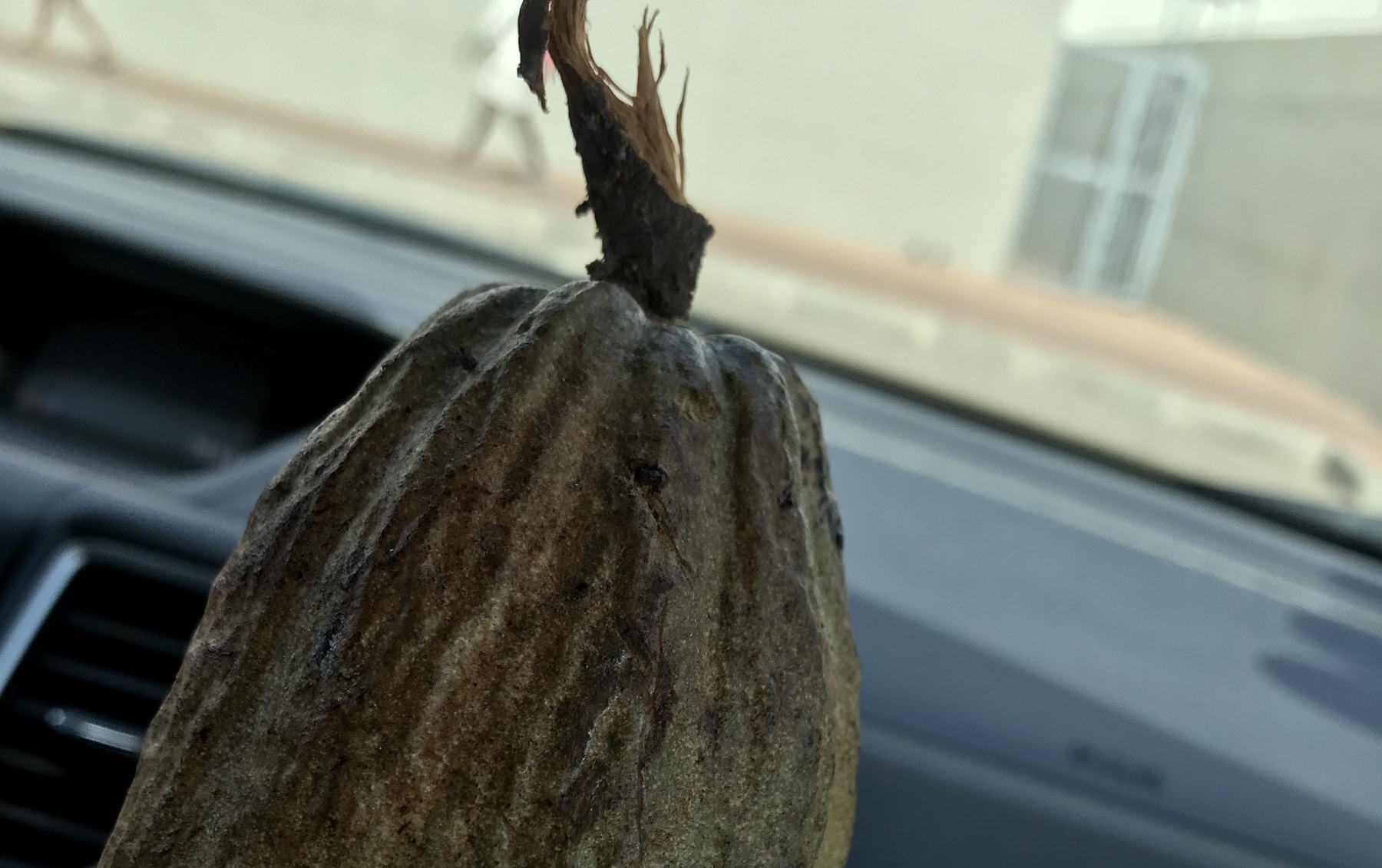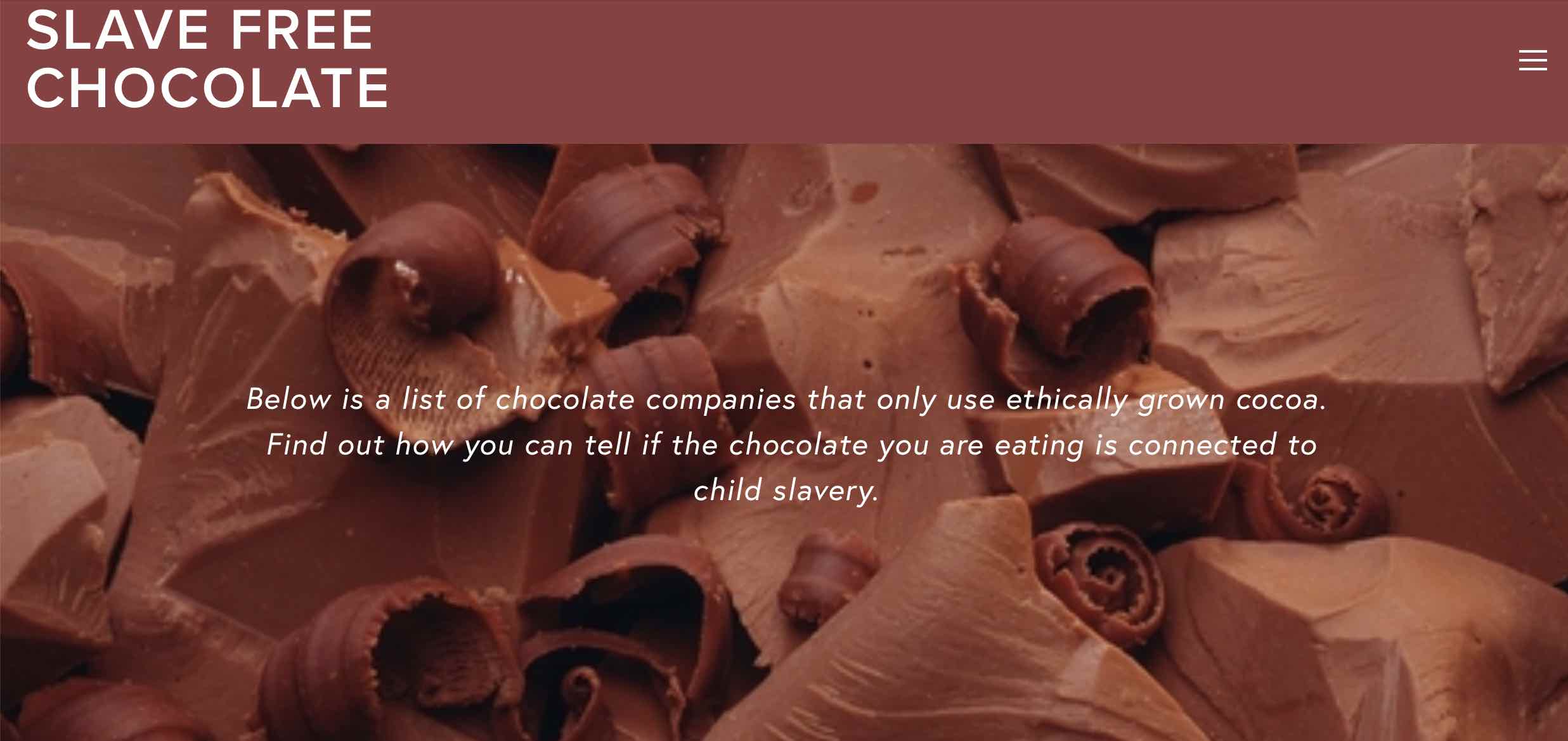A few weeks ago, I learned that there is a cocoa tree at Guinness Ghana here in Accra, where my partner works. While I am living in Ghana, I am making the most of new research opportunities, and here was an unexpected one: What would it be like to harvest and process my own cocoa? Here is the story so far …
 The tree sits right next to the parking lot—note the truck packed with orange crates of Guinness in the background! It’s in front of the staff clinic, and I asked the clinic manager, Anne, if anyone tended it or harvested the fruit. She said no. As you can see, it’s quite feral and has no shade trees for company.
The tree sits right next to the parking lot—note the truck packed with orange crates of Guinness in the background! It’s in front of the staff clinic, and I asked the clinic manager, Anne, if anyone tended it or harvested the fruit. She said no. As you can see, it’s quite feral and has no shade trees for company.
 Still, it was bearing fruit, with more to come—see the bunches of white flowers, some of which will mature into cocoa pods.
Still, it was bearing fruit, with more to come—see the bunches of white flowers, some of which will mature into cocoa pods.
 The first step was to harvest the pods. For those that grow high up on the trees, farmers use a pole with a blade or hook on the end. There happened to be a pole nearby, so I used that. But it was made of plastic and had no hook, so I had to ram the end of the pole into a pod stem over and over until it fell off and rolled across the brick patio.
The first step was to harvest the pods. For those that grow high up on the trees, farmers use a pole with a blade or hook on the end. There happened to be a pole nearby, so I used that. But it was made of plastic and had no hook, so I had to ram the end of the pole into a pod stem over and over until it fell off and rolled across the brick patio.
 Using the bendy pole wasn’t the easiest harvest method, so I began plucking pods from trunk, where I could reach them. My driver, Stanley, grew up in a cocoa farming area, and helped me with the harvest.
Using the bendy pole wasn’t the easiest harvest method, so I began plucking pods from trunk, where I could reach them. My driver, Stanley, grew up in a cocoa farming area, and helped me with the harvest.
 After ten or fifteen minutes, my shopping basket was full of cocoa pods.
After ten or fifteen minutes, my shopping basket was full of cocoa pods.
 Typically, farmers in Ghana leave harvested pods in a pile until family and neighbors can help crack them open and scoop out the seeds, often on a Saturday. I piled my pods on a chair on the balcony at home and planned to break them open on the weekend, when my partner could help. I was full of enthusiasm to begin and had high hopes for the final product already. I imagined that, once fermented and dried, the beans would be plump and flavorful, maybe with a hint of Guinness from the brewery. On an Instagram post, I ambitiously asked for brand name suggestions. Thoughtful friends and family gave creative responses, including “chocodocolate” (natalievanwykartist), “from beer to bean” (avcrofts), and “doc chocolate” (profseanoconnor).
Typically, farmers in Ghana leave harvested pods in a pile until family and neighbors can help crack them open and scoop out the seeds, often on a Saturday. I piled my pods on a chair on the balcony at home and planned to break them open on the weekend, when my partner could help. I was full of enthusiasm to begin and had high hopes for the final product already. I imagined that, once fermented and dried, the beans would be plump and flavorful, maybe with a hint of Guinness from the brewery. On an Instagram post, I ambitiously asked for brand name suggestions. Thoughtful friends and family gave creative responses, including “chocodocolate” (natalievanwykartist), “from beer to bean” (avcrofts), and “doc chocolate” (profseanoconnor).

When we sat down to begin, I had my first revelation: though I have observed every step of cocoa harvest and processing, some of them many times, I didn’t actually know that process. Other languages, including French and Spanish, have different versions of the verb “to know” that distinguish between knowing a person, knowing information, or knowing how to do something. The best we can do in English is to talk about “knowing that” versus “knowing how.”
For example, I know that after harvesting cocoa pods, which are thick and sturdy, farmers often use a machete to break them open. We didn’t have a machete, so I got out a kitchen cleaver, the big one that we use for slicing butternut squash. As I sat there with a pod in one hand and the cleaver in the other, I immediately understood that I did not know the how. It seemed similar to whacking a knife into an avocado stone to extract it. But the cocoa pod was larger, and I had to use a more fearsome knife with more force. It was terrifying to imagine bringing the blade smashing down on the pod. What if I missed? I could easily slice off part of my hand or make a deep cut.
It was too scary to do, so I placed the pod on the balcony and chopped at it with the cleaver. It sometimes took a few tries to make a cut that was deep enough. I then dug my fingers into the cut and wrested the pod apart. It was not an efficient method, and certainly I was not nearly fast enough to operate on a commercial scale. Farmers have to learn how to break open many pods quickly, even if the methods are scary or dangerous.
 My partner and I took turns breaking pods and scooping out seeds. Some of them looked like they had worms crawling out of them, but after a moment I realized that those seeds had germinated. Of course, I knew that cocoa seeds might germinate, but I had no idea if or how that would impact the rest of the process. Would germinated seeds ferment? If they did, would they be usable for making chocolate? Wondering about these questions also made me realize that I had harvested the pods without any thought of whether they were ripe—or over-ripe. I could tell you that pods often change color as they ripen, from green to yellow or orange, but some stay green. I did not know how to tell if the ones on the Guinness tree were ready for harvest.
My partner and I took turns breaking pods and scooping out seeds. Some of them looked like they had worms crawling out of them, but after a moment I realized that those seeds had germinated. Of course, I knew that cocoa seeds might germinate, but I had no idea if or how that would impact the rest of the process. Would germinated seeds ferment? If they did, would they be usable for making chocolate? Wondering about these questions also made me realize that I had harvested the pods without any thought of whether they were ripe—or over-ripe. I could tell you that pods often change color as they ripen, from green to yellow or orange, but some stay green. I did not know how to tell if the ones on the Guinness tree were ready for harvest.

I decided that the safest thing would be to separate the evidently germinated seeds into their own pile. I organized the seeds on a bed of plantain leaves, as I have seen farmers do, and covered them with another layer of waxy fronds. This is called the heap method of fermentation and is common here in Ghana.

I wasn’t sure how messy the process would be, so I laid the whole thing on top of a plastic bag to protect the balcony from being stained. I added a couple of dead potted plants as weights, so that the pile would not blow open in the sometimes-strong breezes.
 Then I had to travel to the UK for a week. I asked my partner to make us a drying table while I was away, and there was a beautiful one waiting for me when I returned. It was too late at night to transfer my beans, so I put an almond on it to judge the scale and prepared to go out in the morning and start the drying process.
Then I had to travel to the UK for a week. I asked my partner to make us a drying table while I was away, and there was a beautiful one waiting for me when I returned. It was too late at night to transfer my beans, so I put an almond on it to judge the scale and prepared to go out in the morning and start the drying process.
 My fermentation heap didn’t look at all as I expected. The plantain leaves had dried and shriveled, and I could see some filthy-looking beans spilling out from one side. When we first got the plantain leaves, I had left them on the balcony overnight. When we went out the next day to crack open the pods, I lifted a frond and a giant cockroach scuttled out. I imagined that the environment of the heap had only become more resource-rich for roaches, and prepared myself for dozens to run out when I lifted up the leaves.
My fermentation heap didn’t look at all as I expected. The plantain leaves had dried and shriveled, and I could see some filthy-looking beans spilling out from one side. When we first got the plantain leaves, I had left them on the balcony overnight. When we went out the next day to crack open the pods, I lifted a frond and a giant cockroach scuttled out. I imagined that the environment of the heap had only become more resource-rich for roaches, and prepared myself for dozens to run out when I lifted up the leaves.
 Well, let me tell you, those beans were so disgusting that not even the cockroaches wanted them! They had gotten terribly molded, and they certainly did not look like any fermented beans I’d seen before. I couldn’t bear to touch them, so I put on food prep gloves to transfer handfuls to the drying mat, trying not to breathe in the mold.
Well, let me tell you, those beans were so disgusting that not even the cockroaches wanted them! They had gotten terribly molded, and they certainly did not look like any fermented beans I’d seen before. I couldn’t bear to touch them, so I put on food prep gloves to transfer handfuls to the drying mat, trying not to breathe in the mold.
 I had been posting pictures of the process on Instagram. When I put up these images, I received an email almost immediately from my friend Steve DeVries, who is a craft chocolate maker and expert in the bean to bar process. He sounded horrified, and sent me references for a half dozen books on cocoa fermentation. Steve wasn’t the only one to be put off. I sat in my living room and watched morosely as a crow alighted on the balcony railing, glanced at the beans, and flew away. No one was interested in my cocoa.
I had been posting pictures of the process on Instagram. When I put up these images, I received an email almost immediately from my friend Steve DeVries, who is a craft chocolate maker and expert in the bean to bar process. He sounded horrified, and sent me references for a half dozen books on cocoa fermentation. Steve wasn’t the only one to be put off. I sat in my living room and watched morosely as a crow alighted on the balcony railing, glanced at the beans, and flew away. No one was interested in my cocoa.
 I still had a shred of optimism that the beans could be saved, though, so I moved the drying mat into the sunshine. They stayed there for more than a week, and I can’t say they improved. I went out one day to stare at them during a writing break, and realized that, while working on a report on Liberia’s cocoa market, I had addressed the challenge of beans going moldy during the rainy season (which is now), if evacuation trucks get stalled on the road. Compared to someone who farms cocoa for a living, I’d done an infinitesimal amount of labor, and I still felt sorrow and frustration at seeing my cocoa spoiled and unusable. How had I typed so dispassionately that beans going moldy was “especially a problem during the rainy season”? What did I know of beans going moldy, until it happened to my harvest? It was repulsive, viscerally so, to see a food I had tended be taken over by another organism.
I still had a shred of optimism that the beans could be saved, though, so I moved the drying mat into the sunshine. They stayed there for more than a week, and I can’t say they improved. I went out one day to stare at them during a writing break, and realized that, while working on a report on Liberia’s cocoa market, I had addressed the challenge of beans going moldy during the rainy season (which is now), if evacuation trucks get stalled on the road. Compared to someone who farms cocoa for a living, I’d done an infinitesimal amount of labor, and I still felt sorrow and frustration at seeing my cocoa spoiled and unusable. How had I typed so dispassionately that beans going moldy was “especially a problem during the rainy season”? What did I know of beans going moldy, until it happened to my harvest? It was repulsive, viscerally so, to see a food I had tended be taken over by another organism.
 I had had a similar realization once before: that as much as I might know about cocoa processing, I lack how knowledge. When I was in Seattle teaching at UW last year, I stopped on my way home from campus one evening at the Chocolate Man shop to take one of Bill Fredericks’s tempering classes. For the first hour, I listened as Bill explained and demonstrated the different tempering methods. I understood everything he was saying; I’d written about the process myself in Cocoa.
I had had a similar realization once before: that as much as I might know about cocoa processing, I lack how knowledge. When I was in Seattle teaching at UW last year, I stopped on my way home from campus one evening at the Chocolate Man shop to take one of Bill Fredericks’s tempering classes. For the first hour, I listened as Bill explained and demonstrated the different tempering methods. I understood everything he was saying; I’d written about the process myself in Cocoa.
But as soon as Bill handed me a bowl and spatula, I realized that I had neither intuition nor a mental map of what was supposed to happen next. I mean, the only thing I had to do was stir the melted chocolate. But of course it is more than that: it’s just knowing that you are doing it right, that the crystallization is happening and the cocoa butter molecules are lining up in their strongest form. As basic as the task was—stirring—I did not know how. I gave it a few half-attempts, and then turned myself to the unnecessary task of cleaning dried chocolate off of equipment and working surfaces for the rest of the evening.
I haven’t returned to hand tempering since, but with this home cocoa processing, I will try again. After all these years researching and writing about cocoa and chocolate, there is so much that I just do not know, and cannot know until I experience it myself—and much of that, I will likely never experience. Having just published a book about the politics of cocoa, from farm to factory to taste, it was stunning to realize that. I have put my whole heart into understanding cocoa through research and writing, but I will do my best now to try out other ways. My next opportunity will be light crop, which happens here in July and August. I will return to the Guinness Ghana cocoa tree then, and see what more I can learn.




